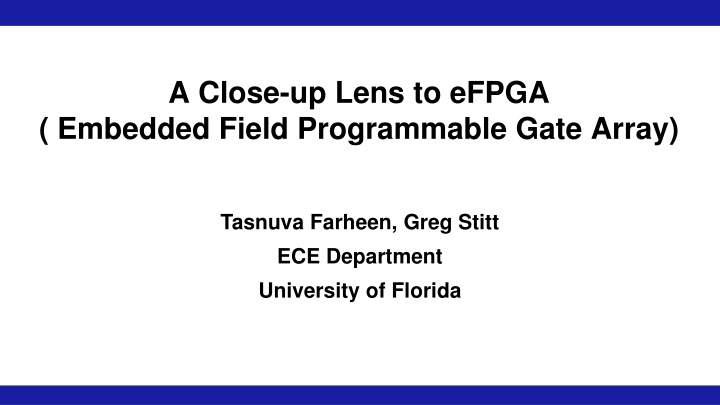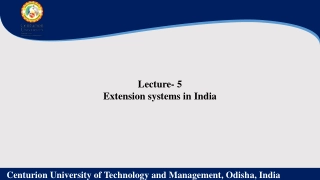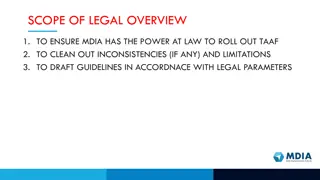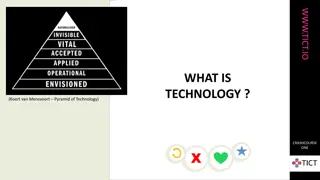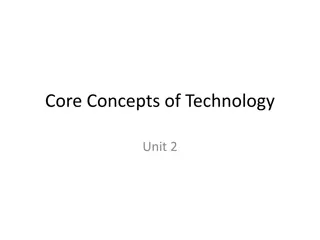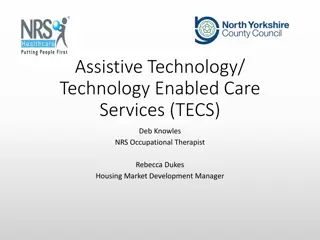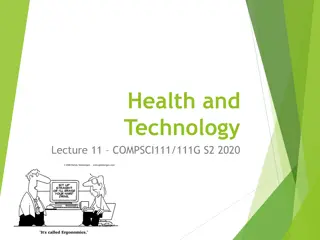eFPGA Technology
eFPGA, or Embedded Field-Programmable Gate Array, offers a reconfigurable building block similar to traditional FPGA cores but with distinct advantages in construction and interconnect design. The evolution from traditional FPGA to eFPGA brings significant benefits in terms of performance, flexibility, and system acceleration. By integrating programmable logic and interconnect networks within ASICs or SoCs, eFPGA addresses critical bottlenecks such as data transfer latency and memory shuffling. This advancement not only optimizes on-chip communication and connectivity but also enhances power efficiency and overall system performance.
Download Presentation

Please find below an Image/Link to download the presentation.
The content on the website is provided AS IS for your information and personal use only. It may not be sold, licensed, or shared on other websites without obtaining consent from the author.If you encounter any issues during the download, it is possible that the publisher has removed the file from their server.
You are allowed to download the files provided on this website for personal or commercial use, subject to the condition that they are used lawfully. All files are the property of their respective owners.
The content on the website is provided AS IS for your information and personal use only. It may not be sold, licensed, or shared on other websites without obtaining consent from the author.
E N D
Presentation Transcript
A Close-up Lens to eFPGA ( Embedded Field Programmable Gate Array) Tasnuva Farheen, Greg Stitt ECE Department University of Florida
What is eFPGA? Typical FPGA Embedded FPGA GPLL GPIO GPLL Hardwired RTL SRAM Processor MPLL High Speed PCI Express Buses receivers Trans GPIO HIP FPGA Core Hardwired RTL DSP eFPGA FPGA Core MPLL GPLL Integrated in a Chip GPLL GPIO No High Speed SERDES, PLLs, hard IP bus interfaces, GPIO Buffers Goes on PCB SOC SOC FPGA FPGA 2
eFPGA Construction Reconfigurable Building Block Like FPGA cores, eFPGA constructed of some building blocks. Programmable logic and interconnect surrounded by CMOS I/O blocks. Every supplier does things similarly. LUTs are LUTs, the inputs/outputs are CMOS and there is always an interconnect network. What varies is LUT size: 4-input LUTs or 6-input LUTs. Reset Cout 6 2 2 3 6-in-2-out LUT FF From Interconnect Network To Interconnect Network 6 Carry Arithmetic 2 Output Selection 2 6-in-2-out LUT 3 Data Multiplexer FF 6 2 2 3 6-in-2-out LUT FF 6 2 2 6-in-2-out LUT 3 FF Cin Aux. Input 3
Traditional FPGA vs. eFPGA 2D-Mesh Interconnects Advantage: As the array size grows (N LUTs), the size of the interconnect grows much less than the traditional mesh interconnect. Estimation: 2X dense interconnect in eFPGA. This is very significant because, 80% of the area is interconnect, only 20% is programmable logic. In an FPGA chip there is usually a fixed ratio of LUTs and MACs(Multiplier Accumulators), but in eFPGA, it is possible to have all-LUTs or a mix of LUTs/MACs as the application requires. O(N-logN) Boundaryless Radix/ Hierarchical Interconnect Network Source @ https://semiengineering.com/introduction-to-efpga-hardware/ 4
Motivation Why use an FPGA at all? Performance and Flexibility Why put a programmable fabric in your ASIC or SoC? Application processor and the FPGA are in separate chips. Communications between the two represent a major bottleneck. No matter how fast the communications between the two devices, the FPGA is always logically far away from the processor. 5
Acceleration System Typical FPGA Acceleration System eFPGA Acceleration System Traditional FPGA: Latency in data transfer, serializing and deserializing Memory Shuffling CPU Cluster FPGA Fabric FPGA Fabric Communication On chip Interconnect Embedded FPGA: Solves latency bottleneck instantiating as much connectivity between the on- chip processor(s) and the FPGA(s) as required by application. Solving memory shuffling by direct access to processor s DDR. DDR DDR PCI Express PCI Express Controller Controller DDR DDR Power Area Performance 6
Programming of eFPGA How do you program an eFPGA? always @ (posedge clk) Y<=A+B; CPU Cluster PCI Express Cache Synthesis Clk A Place & Route LUT DSP LUT LUT B Logic LUT DSP LUT LUT Y Bit Stream Control Unit DSP LUT LUT FPGA Fabric 7
Design Consideration in eFPGA Process Node Compatibility Flexibility in types of RAM Choosing Metal Stack Compatibility Error Protection options Time to Market: 6 months Time to Market: Within Weeks eFPGA process node must be compatible with the rest of the chip whereas in case of traditional FPGA it is not a matter of concern as long as it is fastest Process node matches: Flexibility, Capacity, types of RAM and error protection options 8
Verification of eFPGA Discrete FPGA ASIC Embedded FPGA RTL Wrapper Test Vector Syn Logic to Program FPGA Fabric VHDL/ Verilog Gate FPGA IP (User Block) PNR Netlist Bit Stream Simulation Embedded FPGA as an IP block within the ASIC Two aspects to verify: Programming interface is working correctly Verify all the connections in and out of the user block and the implemented function in the FPGA fabric working correctly in ASIC domain 9
Timing Analysis RBB Timing table for each mode CCS .lib TSMC ASIC S.T.A SDF Timing file for Interconnect (RC) Worst/best (CC) Worst/best T (-40/0/100) C .spef Delay Model RBB 2 RBB 1 RBB 0 LUT FF LUT LUT FF 10
eFPGA Recap The clock(s) for the eFPGA come from the SoC. The configuration of the eFPGA is done by the SoC. The input pins of the eFPGA are driven from the SoC and the output pins of the eFPGA connect to other blocks of the SoC: the connection can be to a system bus like AXI, to the data/control paths, to memory or to I/O or a combination of all of these. SOC Source @ https://semiengineering.com/introduction-to-efpga-Software/ 11
EDA Tools for eFPGA . V . bit . edif Flex Logix EFLX Compiler Bit File for EFLX Synopsys Synplify RTL eFPGA is an RTL engine programmed using Verilog or sometimes VHDL eFPGA execute the RTL cycle by cycle from inputs through the RTL in the eFPGA to the outputs. Synthesis Tool: Synopsys Synplify Synthesis tool reads in the Verilog or VHDL and generates an EDIF file EDIF: a vendor-neutral format to store electronic netlists. The EDIF file then processed by the eFPGA s own software to do packing, placing, routing, timing generation and then bit file generation Each eFPGA s hardware implementation is quite different in terms of LUT sizes, clocking structure, array layout, and especially interconnect network 12
eFPGA Compiler Input: EDIF File Run All in the Compiler: a) select an appropriate array size and configuration b) Generate an appropriate I/O pin mapping file c) Generate an appropriate memory (RAMDEF) file d) Then place/route generate timing The floor planner tool allows to arrays and configure 13 Source @ https://semiengineering.com/introduction-to-efpga-Software/
Placement Viewer Placement viewer allow a designer to see which blocks of the core are utilized Inspect individual timing paths Give insight in to how to optimize the design for improved performance Source @ https://semiengineering.com/introduction-to-efpga-Software/ 14
Timing Analyzer Another tool is the timing analyzer histogram Histogram shows the number of timing paths in each band It is possible to clock on each column of the histogram to see a list of timing paths Each timing path can be selected to see how it breaks down step by step from the clock input of a flop, through the logic and interconnect stages to the setup of the destination flop. Source @ https://semiengineering.com/introduction-to-efpga-Software/ 15
Security in terms of eFPGA System level security with least PPA overhead Provides IP protection The flexibility of burning the bitstream after the fabrication Don t share the IP functionality with any entity of the supply chain Safeguard against counterfeit parts Obfuscating a portion of the ASIC s circuitry in eFPGA Program the eFPGA as part of the ASIC s pre-boot sequence eFPGA can also be used within an IP block itself for specific security requirements in subsystems FPGA Array IO RBB Din Din_i Confidential Design Dout_i Dout Clk 16
Applications Wireless Telecom Industry Specifications are constantly being updated from 3G/4G/5G Meet stringent size, weight, and power requirements Fintech/High-Frequency Trading eFPGA reducing latency by a microsecond can be worth millions of dollars Artificial Intelligence/Machine Learning (AI/ML) Inference and CNNs Convolutional Neural Network (CNN) inference algorithms rely heavily on multiply/accumulate operations and programmable logic Speedcore eFPGAs can significantly accelerate such algorithms using the massive parallelism made possible by including a large number of programmable DSP blocks in eFPGA specification 17
